HEMS Ltd Case Study: Analyzing & Assembling Marketing Models
VerifiedAdded on 2023/06/10
|105
|28724
|177
Case Study
AI Summary
This case study investigates the marketing models employed by HEMS Ltd, a UK-based specialist in tooling repair for heavy machinery, to identify and address issues hindering their business growth. The research aims to assemble a suitable marketing model for the company by first identifying the current marketing situation at HEMS Ltd, exploring various marketing models described in literature, and then providing tailored recommendations for implementation. The study employs a positivism philosophy, deductive approach, and descriptive design, utilizing survey and interview research strategies with non-probability sampling techniques. Qualitative data analysis reveals that HEMS Ltd's marketing shortcomings include a lack of proper market research, inappropriate promotional measures, and failure to meet customer expectations regarding product design and packaging. The study concludes by recommending strategies such as researching the target audience, emphasizing measurable goals, strengthening online presence, making necessary adjustments, maintaining consistency, embracing innovation, and focusing on minute details to enhance HEMS Ltd's marketing effectiveness and overall business performance. This document is available on Desklib, a platform offering a variety of study tools for students.
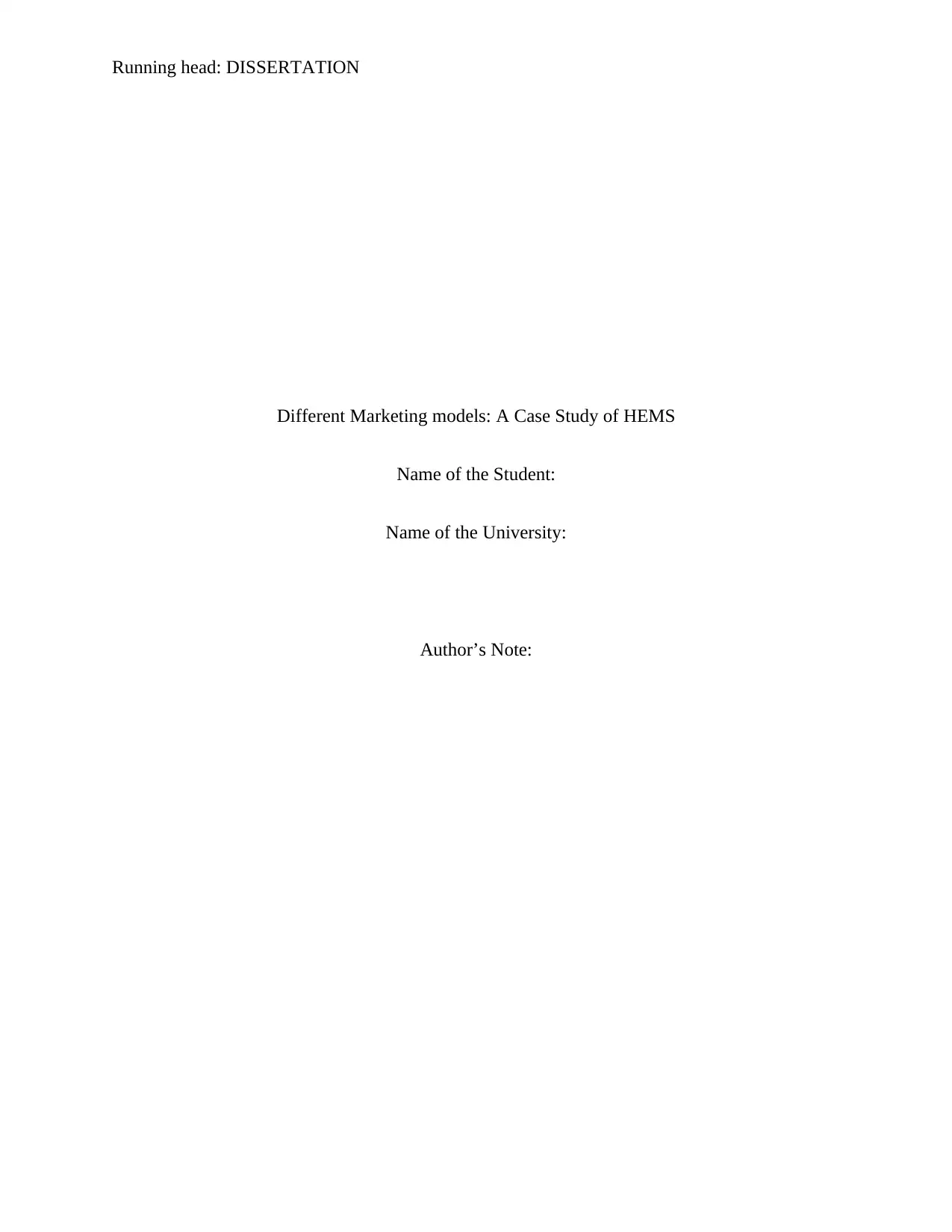
Running head: DISSERTATION
Different Marketing models: A Case Study of HEMS
Name of the Student:
Name of the University:
Author’s Note:
Different Marketing models: A Case Study of HEMS
Name of the Student:
Name of the University:
Author’s Note:
Paraphrase This Document
Need a fresh take? Get an instant paraphrase of this document with our AI Paraphraser
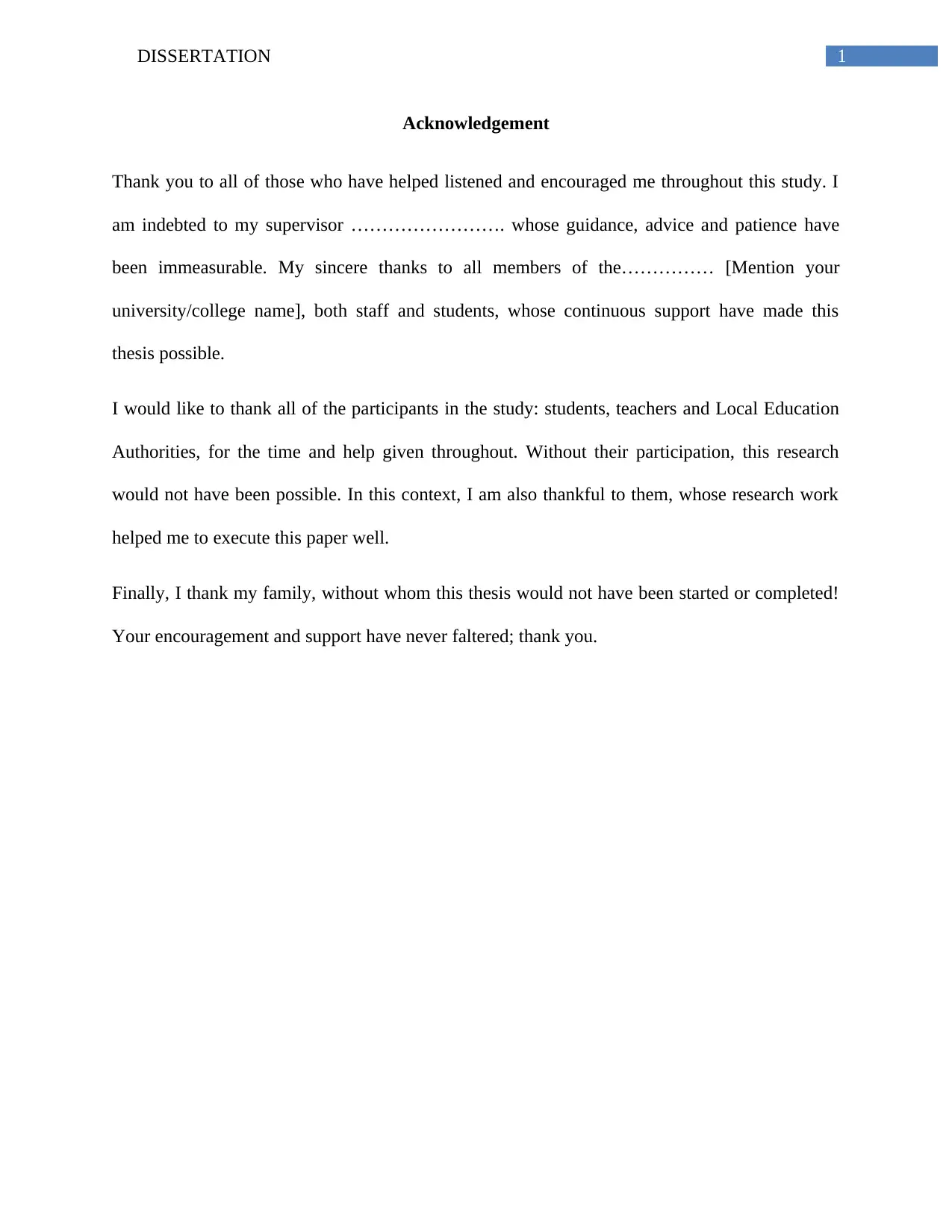
1DISSERTATION
Acknowledgement
Thank you to all of those who have helped listened and encouraged me throughout this study. I
am indebted to my supervisor ……………………. whose guidance, advice and patience have
been immeasurable. My sincere thanks to all members of the…………… [Mention your
university/college name], both staff and students, whose continuous support have made this
thesis possible.
I would like to thank all of the participants in the study: students, teachers and Local Education
Authorities, for the time and help given throughout. Without their participation, this research
would not have been possible. In this context, I am also thankful to them, whose research work
helped me to execute this paper well.
Finally, I thank my family, without whom this thesis would not have been started or completed!
Your encouragement and support have never faltered; thank you.
Acknowledgement
Thank you to all of those who have helped listened and encouraged me throughout this study. I
am indebted to my supervisor ……………………. whose guidance, advice and patience have
been immeasurable. My sincere thanks to all members of the…………… [Mention your
university/college name], both staff and students, whose continuous support have made this
thesis possible.
I would like to thank all of the participants in the study: students, teachers and Local Education
Authorities, for the time and help given throughout. Without their participation, this research
would not have been possible. In this context, I am also thankful to them, whose research work
helped me to execute this paper well.
Finally, I thank my family, without whom this thesis would not have been started or completed!
Your encouragement and support have never faltered; thank you.
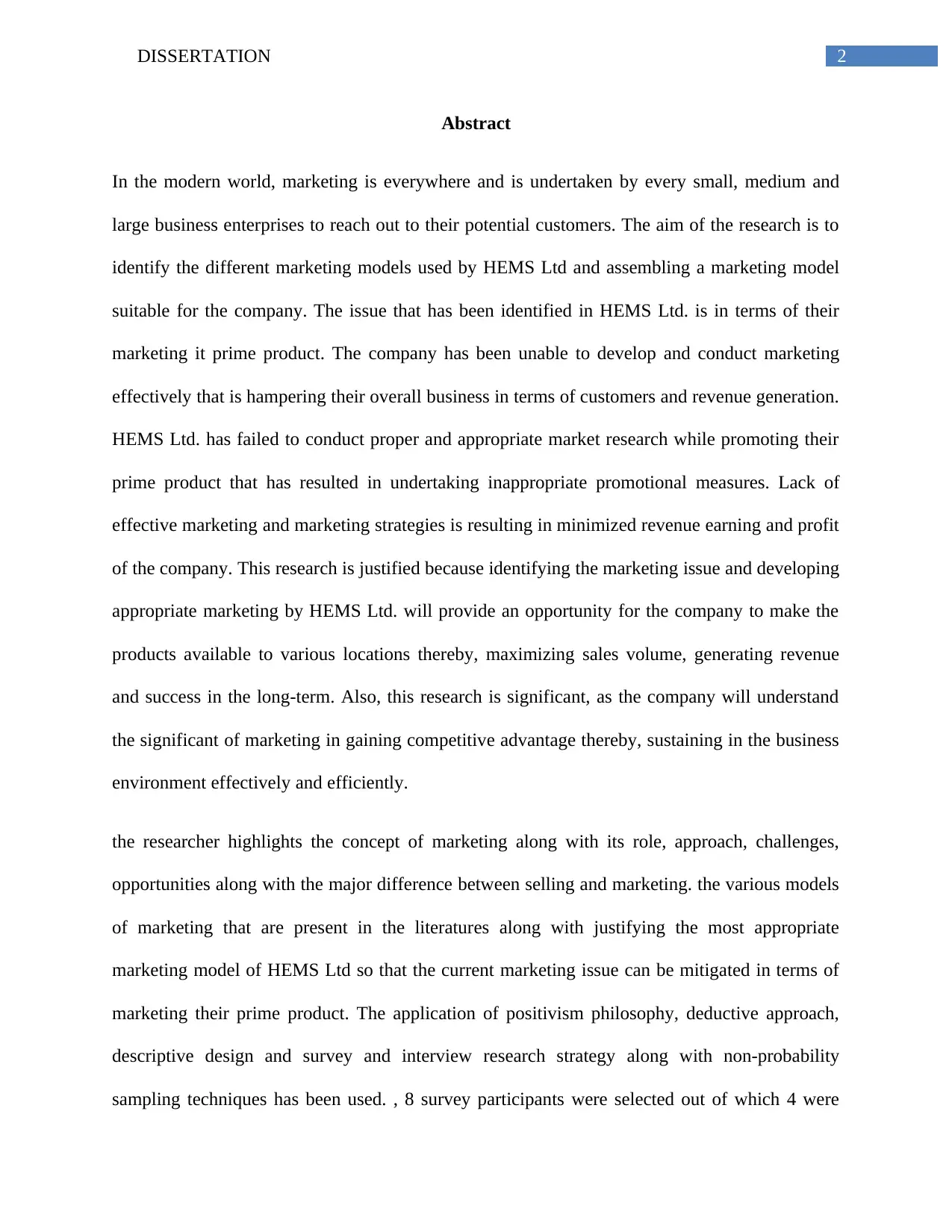
2DISSERTATION
Abstract
In the modern world, marketing is everywhere and is undertaken by every small, medium and
large business enterprises to reach out to their potential customers. The aim of the research is to
identify the different marketing models used by HEMS Ltd and assembling a marketing model
suitable for the company. The issue that has been identified in HEMS Ltd. is in terms of their
marketing it prime product. The company has been unable to develop and conduct marketing
effectively that is hampering their overall business in terms of customers and revenue generation.
HEMS Ltd. has failed to conduct proper and appropriate market research while promoting their
prime product that has resulted in undertaking inappropriate promotional measures. Lack of
effective marketing and marketing strategies is resulting in minimized revenue earning and profit
of the company. This research is justified because identifying the marketing issue and developing
appropriate marketing by HEMS Ltd. will provide an opportunity for the company to make the
products available to various locations thereby, maximizing sales volume, generating revenue
and success in the long-term. Also, this research is significant, as the company will understand
the significant of marketing in gaining competitive advantage thereby, sustaining in the business
environment effectively and efficiently.
the researcher highlights the concept of marketing along with its role, approach, challenges,
opportunities along with the major difference between selling and marketing. the various models
of marketing that are present in the literatures along with justifying the most appropriate
marketing model of HEMS Ltd so that the current marketing issue can be mitigated in terms of
marketing their prime product. The application of positivism philosophy, deductive approach,
descriptive design and survey and interview research strategy along with non-probability
sampling techniques has been used. , 8 survey participants were selected out of which 4 were
Abstract
In the modern world, marketing is everywhere and is undertaken by every small, medium and
large business enterprises to reach out to their potential customers. The aim of the research is to
identify the different marketing models used by HEMS Ltd and assembling a marketing model
suitable for the company. The issue that has been identified in HEMS Ltd. is in terms of their
marketing it prime product. The company has been unable to develop and conduct marketing
effectively that is hampering their overall business in terms of customers and revenue generation.
HEMS Ltd. has failed to conduct proper and appropriate market research while promoting their
prime product that has resulted in undertaking inappropriate promotional measures. Lack of
effective marketing and marketing strategies is resulting in minimized revenue earning and profit
of the company. This research is justified because identifying the marketing issue and developing
appropriate marketing by HEMS Ltd. will provide an opportunity for the company to make the
products available to various locations thereby, maximizing sales volume, generating revenue
and success in the long-term. Also, this research is significant, as the company will understand
the significant of marketing in gaining competitive advantage thereby, sustaining in the business
environment effectively and efficiently.
the researcher highlights the concept of marketing along with its role, approach, challenges,
opportunities along with the major difference between selling and marketing. the various models
of marketing that are present in the literatures along with justifying the most appropriate
marketing model of HEMS Ltd so that the current marketing issue can be mitigated in terms of
marketing their prime product. The application of positivism philosophy, deductive approach,
descriptive design and survey and interview research strategy along with non-probability
sampling techniques has been used. , 8 survey participants were selected out of which 4 were
⊘ This is a preview!⊘
Do you want full access?
Subscribe today to unlock all pages.

Trusted by 1+ million students worldwide
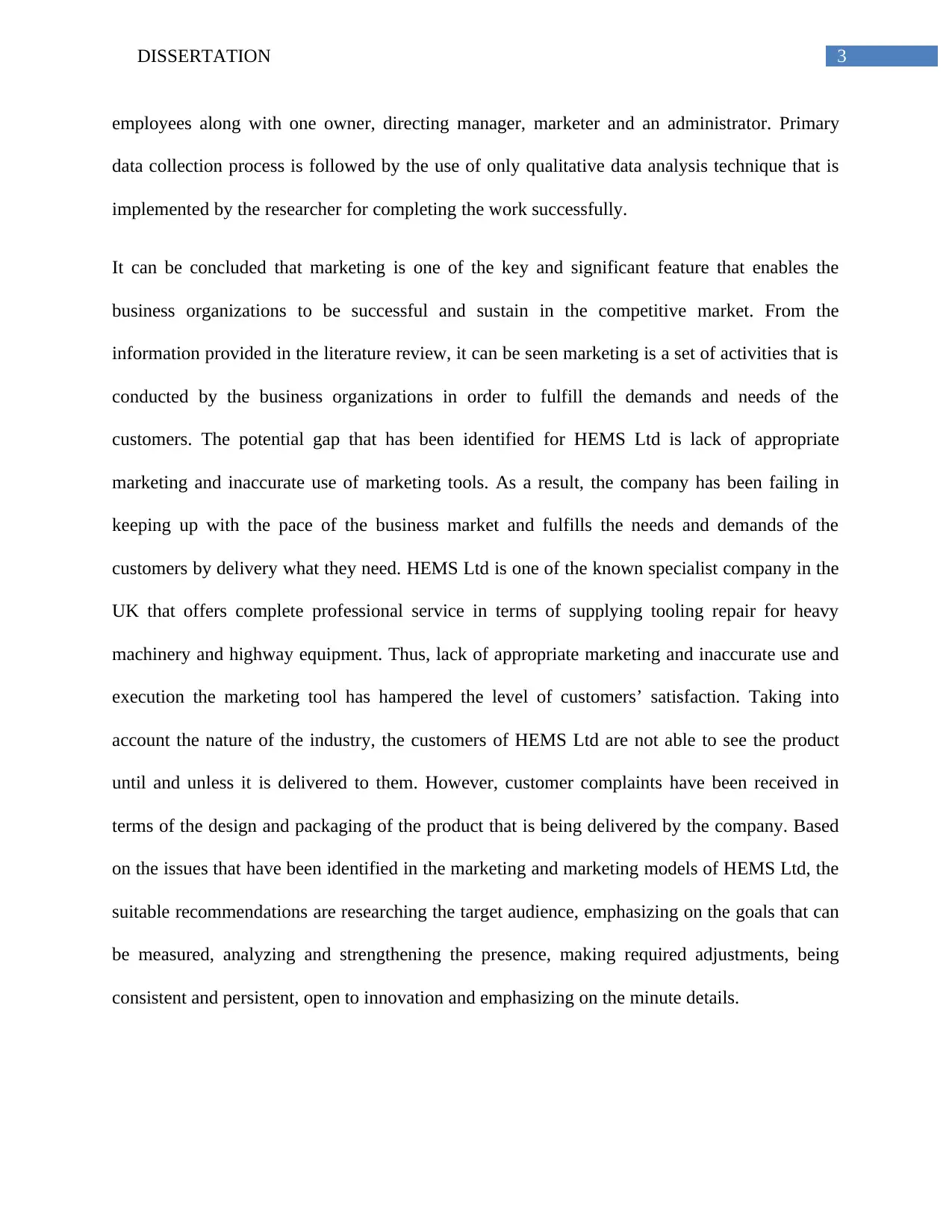
3DISSERTATION
employees along with one owner, directing manager, marketer and an administrator. Primary
data collection process is followed by the use of only qualitative data analysis technique that is
implemented by the researcher for completing the work successfully.
It can be concluded that marketing is one of the key and significant feature that enables the
business organizations to be successful and sustain in the competitive market. From the
information provided in the literature review, it can be seen marketing is a set of activities that is
conducted by the business organizations in order to fulfill the demands and needs of the
customers. The potential gap that has been identified for HEMS Ltd is lack of appropriate
marketing and inaccurate use of marketing tools. As a result, the company has been failing in
keeping up with the pace of the business market and fulfills the needs and demands of the
customers by delivery what they need. HEMS Ltd is one of the known specialist company in the
UK that offers complete professional service in terms of supplying tooling repair for heavy
machinery and highway equipment. Thus, lack of appropriate marketing and inaccurate use and
execution the marketing tool has hampered the level of customers’ satisfaction. Taking into
account the nature of the industry, the customers of HEMS Ltd are not able to see the product
until and unless it is delivered to them. However, customer complaints have been received in
terms of the design and packaging of the product that is being delivered by the company. Based
on the issues that have been identified in the marketing and marketing models of HEMS Ltd, the
suitable recommendations are researching the target audience, emphasizing on the goals that can
be measured, analyzing and strengthening the presence, making required adjustments, being
consistent and persistent, open to innovation and emphasizing on the minute details.
employees along with one owner, directing manager, marketer and an administrator. Primary
data collection process is followed by the use of only qualitative data analysis technique that is
implemented by the researcher for completing the work successfully.
It can be concluded that marketing is one of the key and significant feature that enables the
business organizations to be successful and sustain in the competitive market. From the
information provided in the literature review, it can be seen marketing is a set of activities that is
conducted by the business organizations in order to fulfill the demands and needs of the
customers. The potential gap that has been identified for HEMS Ltd is lack of appropriate
marketing and inaccurate use of marketing tools. As a result, the company has been failing in
keeping up with the pace of the business market and fulfills the needs and demands of the
customers by delivery what they need. HEMS Ltd is one of the known specialist company in the
UK that offers complete professional service in terms of supplying tooling repair for heavy
machinery and highway equipment. Thus, lack of appropriate marketing and inaccurate use and
execution the marketing tool has hampered the level of customers’ satisfaction. Taking into
account the nature of the industry, the customers of HEMS Ltd are not able to see the product
until and unless it is delivered to them. However, customer complaints have been received in
terms of the design and packaging of the product that is being delivered by the company. Based
on the issues that have been identified in the marketing and marketing models of HEMS Ltd, the
suitable recommendations are researching the target audience, emphasizing on the goals that can
be measured, analyzing and strengthening the presence, making required adjustments, being
consistent and persistent, open to innovation and emphasizing on the minute details.
Paraphrase This Document
Need a fresh take? Get an instant paraphrase of this document with our AI Paraphraser
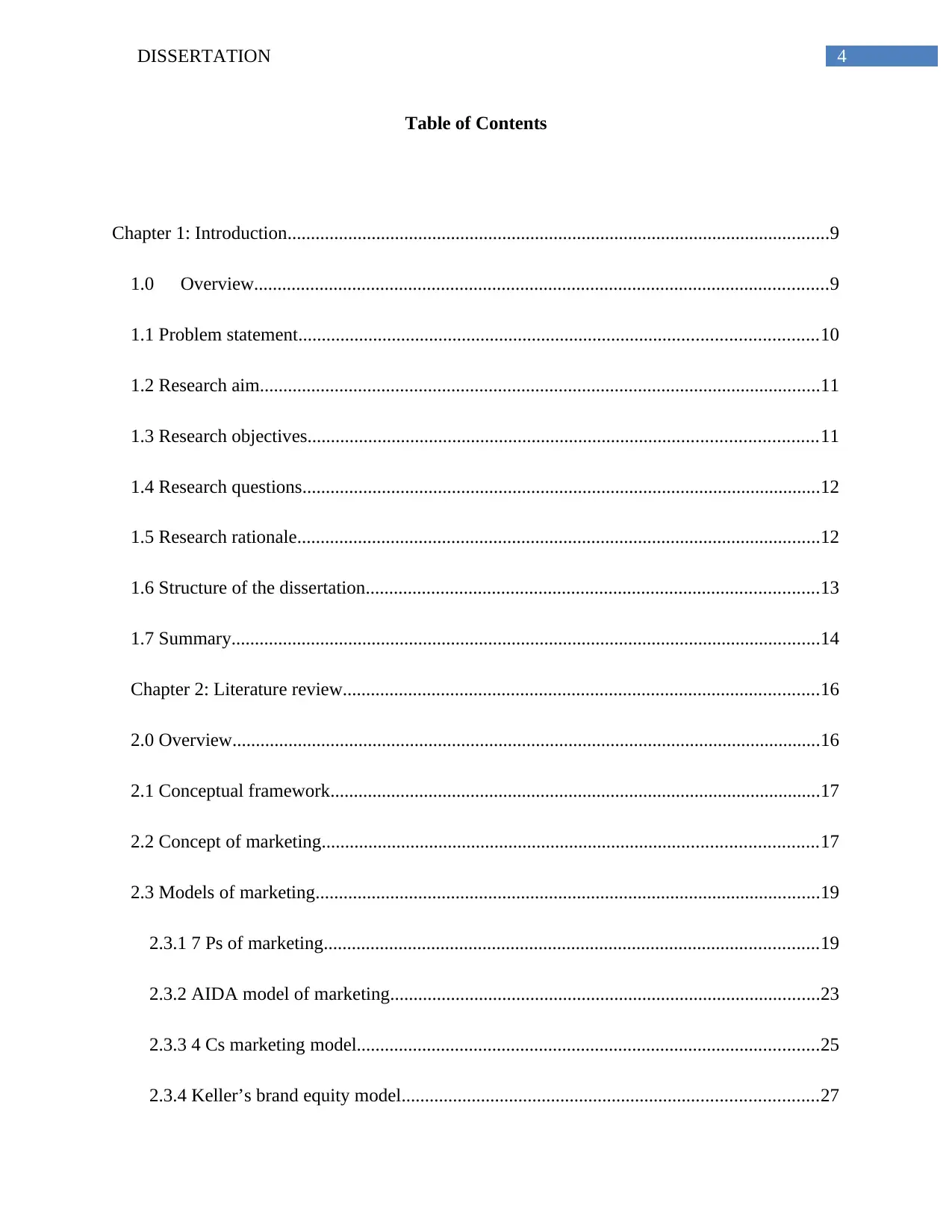
4DISSERTATION
Table of Contents
Chapter 1: Introduction....................................................................................................................9
1.0 Overview...........................................................................................................................9
1.1 Problem statement...............................................................................................................10
1.2 Research aim........................................................................................................................11
1.3 Research objectives.............................................................................................................11
1.4 Research questions...............................................................................................................12
1.5 Research rationale................................................................................................................12
1.6 Structure of the dissertation.................................................................................................13
1.7 Summary..............................................................................................................................14
Chapter 2: Literature review......................................................................................................16
2.0 Overview..............................................................................................................................16
2.1 Conceptual framework.........................................................................................................17
2.2 Concept of marketing..........................................................................................................17
2.3 Models of marketing............................................................................................................19
2.3.1 7 Ps of marketing..........................................................................................................19
2.3.2 AIDA model of marketing............................................................................................23
2.3.3 4 Cs marketing model...................................................................................................25
2.3.4 Keller’s brand equity model.........................................................................................27
Table of Contents
Chapter 1: Introduction....................................................................................................................9
1.0 Overview...........................................................................................................................9
1.1 Problem statement...............................................................................................................10
1.2 Research aim........................................................................................................................11
1.3 Research objectives.............................................................................................................11
1.4 Research questions...............................................................................................................12
1.5 Research rationale................................................................................................................12
1.6 Structure of the dissertation.................................................................................................13
1.7 Summary..............................................................................................................................14
Chapter 2: Literature review......................................................................................................16
2.0 Overview..............................................................................................................................16
2.1 Conceptual framework.........................................................................................................17
2.2 Concept of marketing..........................................................................................................17
2.3 Models of marketing............................................................................................................19
2.3.1 7 Ps of marketing..........................................................................................................19
2.3.2 AIDA model of marketing............................................................................................23
2.3.3 4 Cs marketing model...................................................................................................25
2.3.4 Keller’s brand equity model.........................................................................................27
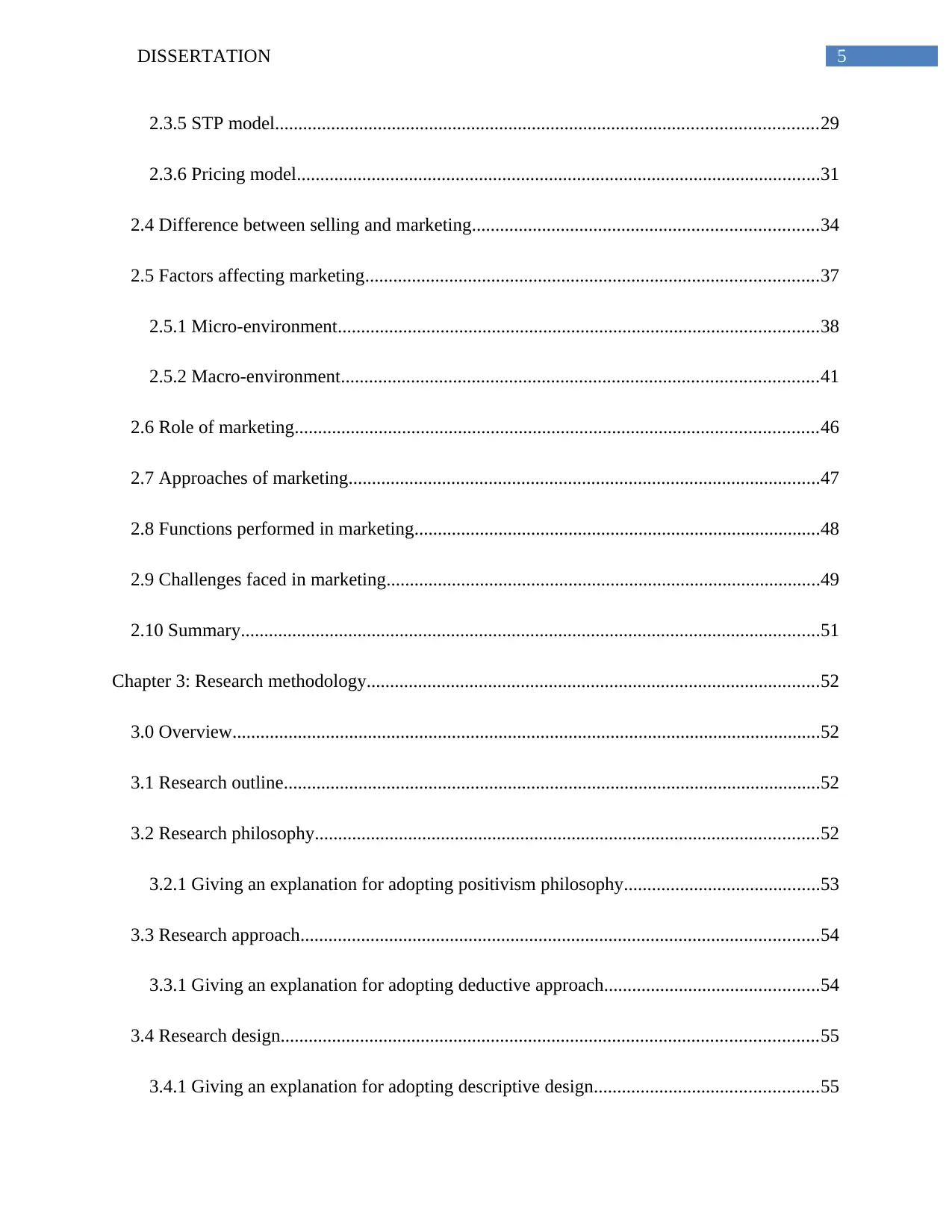
5DISSERTATION
2.3.5 STP model....................................................................................................................29
2.3.6 Pricing model................................................................................................................31
2.4 Difference between selling and marketing..........................................................................34
2.5 Factors affecting marketing.................................................................................................37
2.5.1 Micro-environment.......................................................................................................38
2.5.2 Macro-environment......................................................................................................41
2.6 Role of marketing................................................................................................................46
2.7 Approaches of marketing.....................................................................................................47
2.8 Functions performed in marketing.......................................................................................48
2.9 Challenges faced in marketing.............................................................................................49
2.10 Summary............................................................................................................................51
Chapter 3: Research methodology.................................................................................................52
3.0 Overview..............................................................................................................................52
3.1 Research outline...................................................................................................................52
3.2 Research philosophy............................................................................................................52
3.2.1 Giving an explanation for adopting positivism philosophy..........................................53
3.3 Research approach...............................................................................................................54
3.3.1 Giving an explanation for adopting deductive approach..............................................54
3.4 Research design...................................................................................................................55
3.4.1 Giving an explanation for adopting descriptive design................................................55
2.3.5 STP model....................................................................................................................29
2.3.6 Pricing model................................................................................................................31
2.4 Difference between selling and marketing..........................................................................34
2.5 Factors affecting marketing.................................................................................................37
2.5.1 Micro-environment.......................................................................................................38
2.5.2 Macro-environment......................................................................................................41
2.6 Role of marketing................................................................................................................46
2.7 Approaches of marketing.....................................................................................................47
2.8 Functions performed in marketing.......................................................................................48
2.9 Challenges faced in marketing.............................................................................................49
2.10 Summary............................................................................................................................51
Chapter 3: Research methodology.................................................................................................52
3.0 Overview..............................................................................................................................52
3.1 Research outline...................................................................................................................52
3.2 Research philosophy............................................................................................................52
3.2.1 Giving an explanation for adopting positivism philosophy..........................................53
3.3 Research approach...............................................................................................................54
3.3.1 Giving an explanation for adopting deductive approach..............................................54
3.4 Research design...................................................................................................................55
3.4.1 Giving an explanation for adopting descriptive design................................................55
⊘ This is a preview!⊘
Do you want full access?
Subscribe today to unlock all pages.

Trusted by 1+ million students worldwide
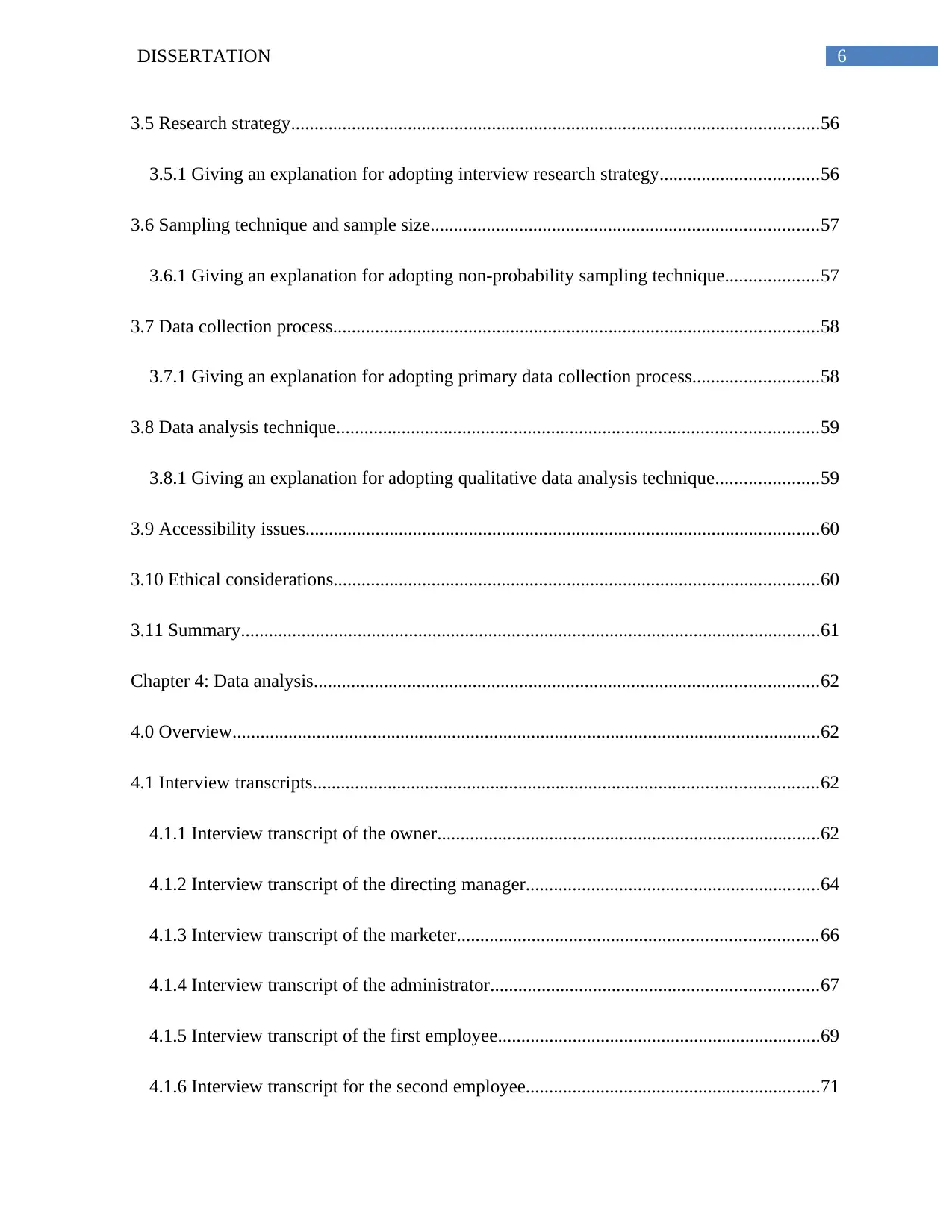
6DISSERTATION
3.5 Research strategy.................................................................................................................56
3.5.1 Giving an explanation for adopting interview research strategy..................................56
3.6 Sampling technique and sample size...................................................................................57
3.6.1 Giving an explanation for adopting non-probability sampling technique....................57
3.7 Data collection process........................................................................................................58
3.7.1 Giving an explanation for adopting primary data collection process...........................58
3.8 Data analysis technique.......................................................................................................59
3.8.1 Giving an explanation for adopting qualitative data analysis technique......................59
3.9 Accessibility issues..............................................................................................................60
3.10 Ethical considerations........................................................................................................60
3.11 Summary............................................................................................................................61
Chapter 4: Data analysis............................................................................................................62
4.0 Overview..............................................................................................................................62
4.1 Interview transcripts............................................................................................................62
4.1.1 Interview transcript of the owner..................................................................................62
4.1.2 Interview transcript of the directing manager...............................................................64
4.1.3 Interview transcript of the marketer.............................................................................66
4.1.4 Interview transcript of the administrator......................................................................67
4.1.5 Interview transcript of the first employee.....................................................................69
4.1.6 Interview transcript for the second employee...............................................................71
3.5 Research strategy.................................................................................................................56
3.5.1 Giving an explanation for adopting interview research strategy..................................56
3.6 Sampling technique and sample size...................................................................................57
3.6.1 Giving an explanation for adopting non-probability sampling technique....................57
3.7 Data collection process........................................................................................................58
3.7.1 Giving an explanation for adopting primary data collection process...........................58
3.8 Data analysis technique.......................................................................................................59
3.8.1 Giving an explanation for adopting qualitative data analysis technique......................59
3.9 Accessibility issues..............................................................................................................60
3.10 Ethical considerations........................................................................................................60
3.11 Summary............................................................................................................................61
Chapter 4: Data analysis............................................................................................................62
4.0 Overview..............................................................................................................................62
4.1 Interview transcripts............................................................................................................62
4.1.1 Interview transcript of the owner..................................................................................62
4.1.2 Interview transcript of the directing manager...............................................................64
4.1.3 Interview transcript of the marketer.............................................................................66
4.1.4 Interview transcript of the administrator......................................................................67
4.1.5 Interview transcript of the first employee.....................................................................69
4.1.6 Interview transcript for the second employee...............................................................71
Paraphrase This Document
Need a fresh take? Get an instant paraphrase of this document with our AI Paraphraser
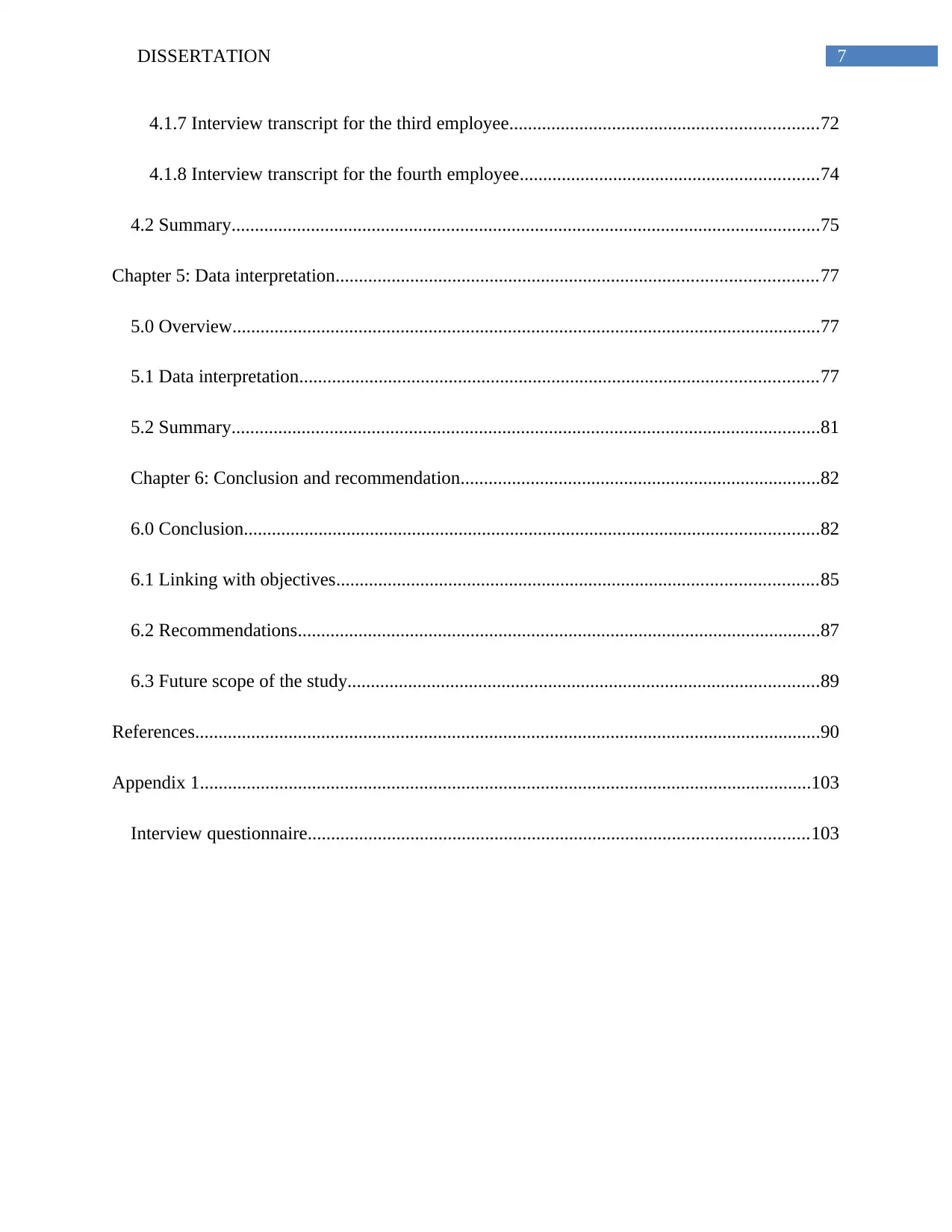
7DISSERTATION
4.1.7 Interview transcript for the third employee..................................................................72
4.1.8 Interview transcript for the fourth employee................................................................74
4.2 Summary..............................................................................................................................75
Chapter 5: Data interpretation.......................................................................................................77
5.0 Overview..............................................................................................................................77
5.1 Data interpretation...............................................................................................................77
5.2 Summary..............................................................................................................................81
Chapter 6: Conclusion and recommendation.............................................................................82
6.0 Conclusion...........................................................................................................................82
6.1 Linking with objectives.......................................................................................................85
6.2 Recommendations................................................................................................................87
6.3 Future scope of the study.....................................................................................................89
References......................................................................................................................................90
Appendix 1...................................................................................................................................103
Interview questionnaire...........................................................................................................103
4.1.7 Interview transcript for the third employee..................................................................72
4.1.8 Interview transcript for the fourth employee................................................................74
4.2 Summary..............................................................................................................................75
Chapter 5: Data interpretation.......................................................................................................77
5.0 Overview..............................................................................................................................77
5.1 Data interpretation...............................................................................................................77
5.2 Summary..............................................................................................................................81
Chapter 6: Conclusion and recommendation.............................................................................82
6.0 Conclusion...........................................................................................................................82
6.1 Linking with objectives.......................................................................................................85
6.2 Recommendations................................................................................................................87
6.3 Future scope of the study.....................................................................................................89
References......................................................................................................................................90
Appendix 1...................................................................................................................................103
Interview questionnaire...........................................................................................................103
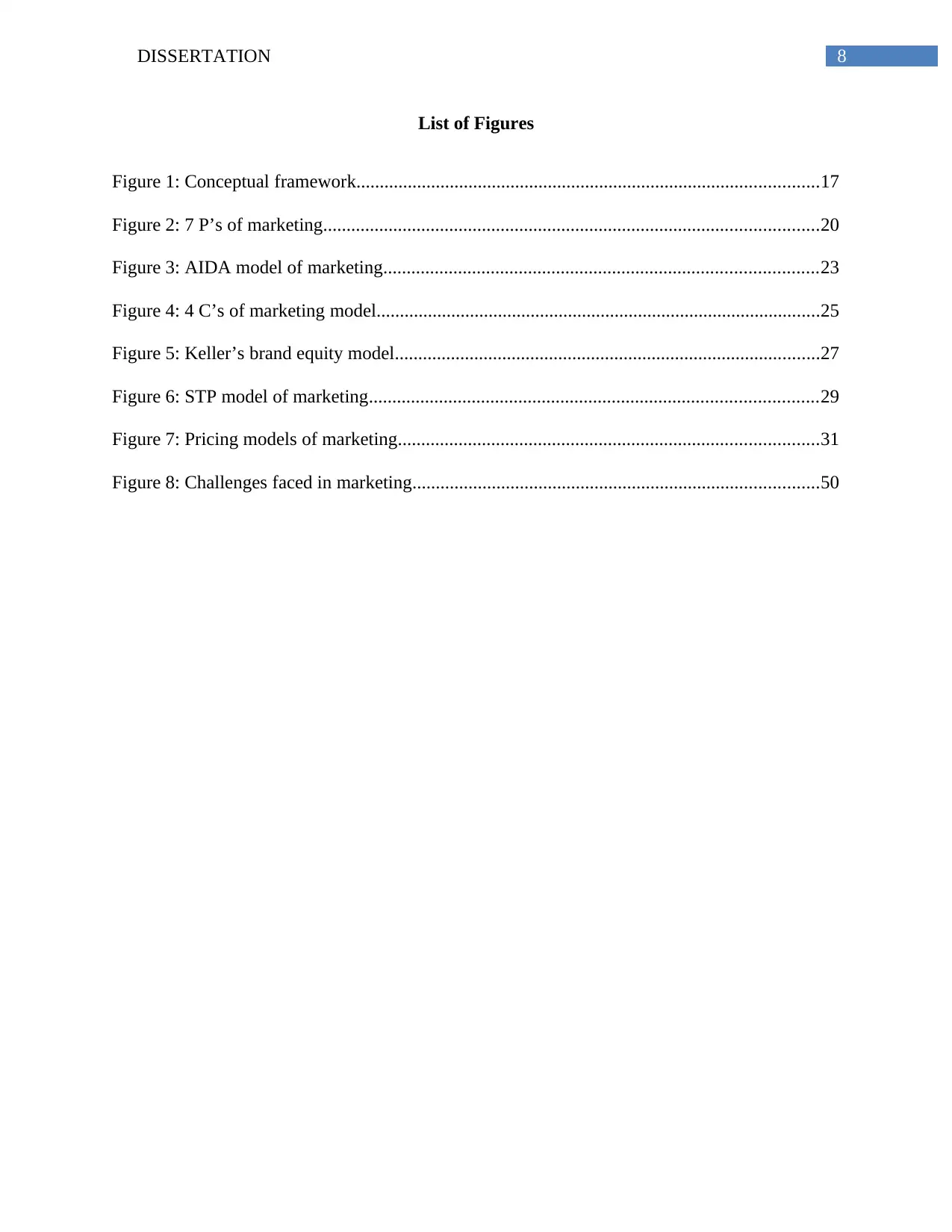
8DISSERTATION
List of Figures
Figure 1: Conceptual framework...................................................................................................17
Figure 2: 7 P’s of marketing..........................................................................................................20
Figure 3: AIDA model of marketing.............................................................................................23
Figure 4: 4 C’s of marketing model...............................................................................................25
Figure 5: Keller’s brand equity model...........................................................................................27
Figure 6: STP model of marketing................................................................................................29
Figure 7: Pricing models of marketing..........................................................................................31
Figure 8: Challenges faced in marketing.......................................................................................50
List of Figures
Figure 1: Conceptual framework...................................................................................................17
Figure 2: 7 P’s of marketing..........................................................................................................20
Figure 3: AIDA model of marketing.............................................................................................23
Figure 4: 4 C’s of marketing model...............................................................................................25
Figure 5: Keller’s brand equity model...........................................................................................27
Figure 6: STP model of marketing................................................................................................29
Figure 7: Pricing models of marketing..........................................................................................31
Figure 8: Challenges faced in marketing.......................................................................................50
⊘ This is a preview!⊘
Do you want full access?
Subscribe today to unlock all pages.

Trusted by 1+ million students worldwide
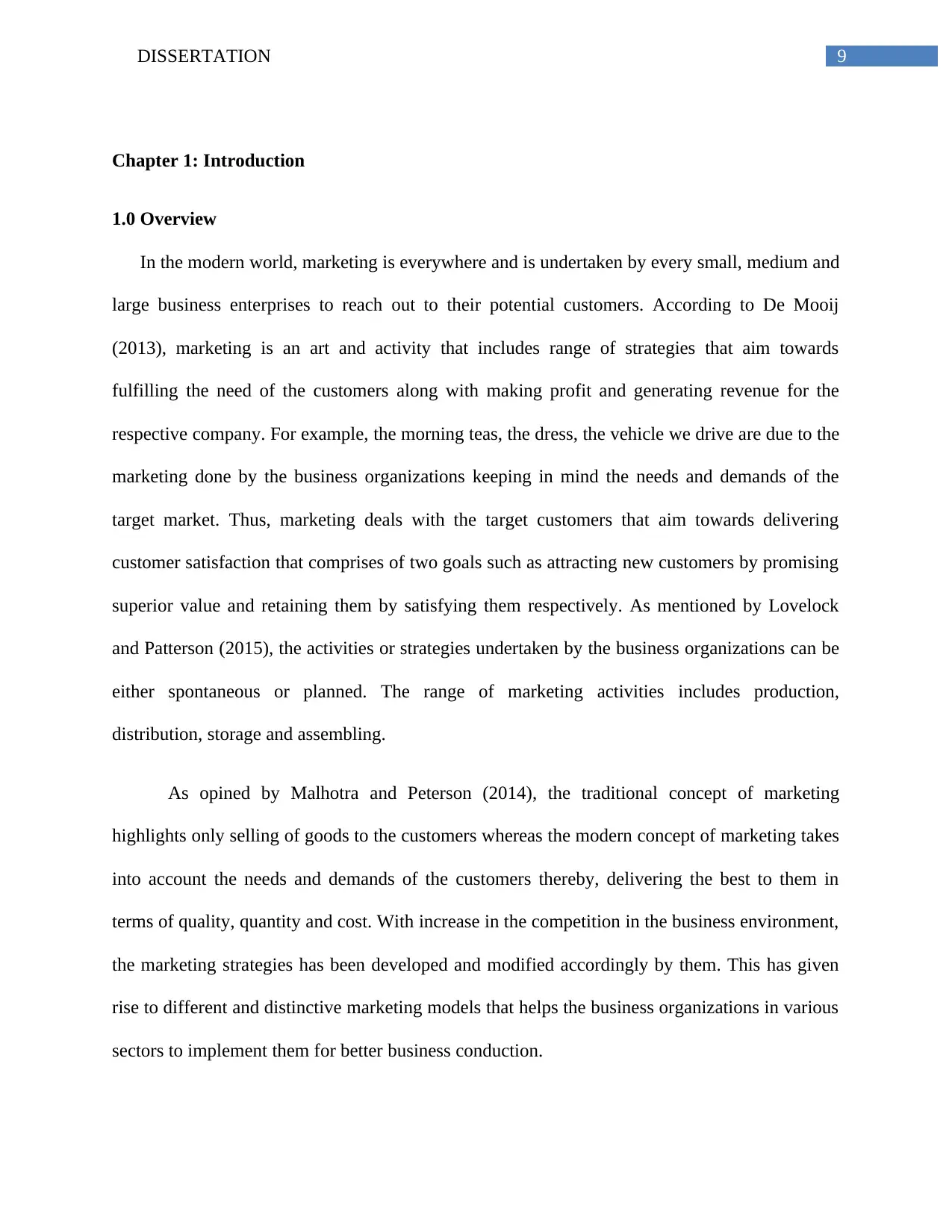
9DISSERTATION
Chapter 1: Introduction
1.0 Overview
In the modern world, marketing is everywhere and is undertaken by every small, medium and
large business enterprises to reach out to their potential customers. According to De Mooij
(2013), marketing is an art and activity that includes range of strategies that aim towards
fulfilling the need of the customers along with making profit and generating revenue for the
respective company. For example, the morning teas, the dress, the vehicle we drive are due to the
marketing done by the business organizations keeping in mind the needs and demands of the
target market. Thus, marketing deals with the target customers that aim towards delivering
customer satisfaction that comprises of two goals such as attracting new customers by promising
superior value and retaining them by satisfying them respectively. As mentioned by Lovelock
and Patterson (2015), the activities or strategies undertaken by the business organizations can be
either spontaneous or planned. The range of marketing activities includes production,
distribution, storage and assembling.
As opined by Malhotra and Peterson (2014), the traditional concept of marketing
highlights only selling of goods to the customers whereas the modern concept of marketing takes
into account the needs and demands of the customers thereby, delivering the best to them in
terms of quality, quantity and cost. With increase in the competition in the business environment,
the marketing strategies has been developed and modified accordingly by them. This has given
rise to different and distinctive marketing models that helps the business organizations in various
sectors to implement them for better business conduction.
Chapter 1: Introduction
1.0 Overview
In the modern world, marketing is everywhere and is undertaken by every small, medium and
large business enterprises to reach out to their potential customers. According to De Mooij
(2013), marketing is an art and activity that includes range of strategies that aim towards
fulfilling the need of the customers along with making profit and generating revenue for the
respective company. For example, the morning teas, the dress, the vehicle we drive are due to the
marketing done by the business organizations keeping in mind the needs and demands of the
target market. Thus, marketing deals with the target customers that aim towards delivering
customer satisfaction that comprises of two goals such as attracting new customers by promising
superior value and retaining them by satisfying them respectively. As mentioned by Lovelock
and Patterson (2015), the activities or strategies undertaken by the business organizations can be
either spontaneous or planned. The range of marketing activities includes production,
distribution, storage and assembling.
As opined by Malhotra and Peterson (2014), the traditional concept of marketing
highlights only selling of goods to the customers whereas the modern concept of marketing takes
into account the needs and demands of the customers thereby, delivering the best to them in
terms of quality, quantity and cost. With increase in the competition in the business environment,
the marketing strategies has been developed and modified accordingly by them. This has given
rise to different and distinctive marketing models that helps the business organizations in various
sectors to implement them for better business conduction.
Paraphrase This Document
Need a fresh take? Get an instant paraphrase of this document with our AI Paraphraser
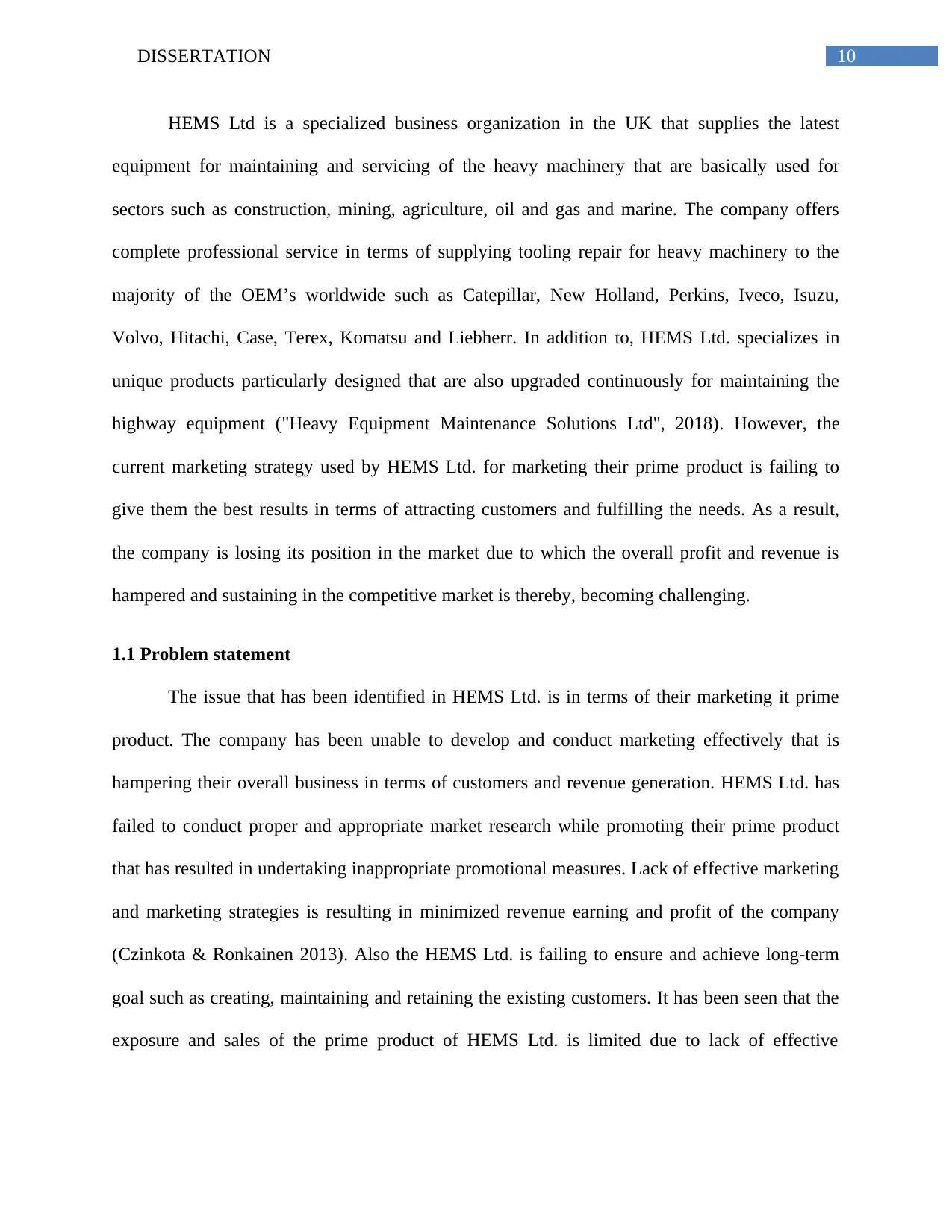
10DISSERTATION
HEMS Ltd is a specialized business organization in the UK that supplies the latest
equipment for maintaining and servicing of the heavy machinery that are basically used for
sectors such as construction, mining, agriculture, oil and gas and marine. The company offers
complete professional service in terms of supplying tooling repair for heavy machinery to the
majority of the OEM’s worldwide such as Catepillar, New Holland, Perkins, Iveco, Isuzu,
Volvo, Hitachi, Case, Terex, Komatsu and Liebherr. In addition to, HEMS Ltd. specializes in
unique products particularly designed that are also upgraded continuously for maintaining the
highway equipment ("Heavy Equipment Maintenance Solutions Ltd", 2018). However, the
current marketing strategy used by HEMS Ltd. for marketing their prime product is failing to
give them the best results in terms of attracting customers and fulfilling the needs. As a result,
the company is losing its position in the market due to which the overall profit and revenue is
hampered and sustaining in the competitive market is thereby, becoming challenging.
1.1 Problem statement
The issue that has been identified in HEMS Ltd. is in terms of their marketing it prime
product. The company has been unable to develop and conduct marketing effectively that is
hampering their overall business in terms of customers and revenue generation. HEMS Ltd. has
failed to conduct proper and appropriate market research while promoting their prime product
that has resulted in undertaking inappropriate promotional measures. Lack of effective marketing
and marketing strategies is resulting in minimized revenue earning and profit of the company
(Czinkota & Ronkainen 2013). Also the HEMS Ltd. is failing to ensure and achieve long-term
goal such as creating, maintaining and retaining the existing customers. It has been seen that the
exposure and sales of the prime product of HEMS Ltd. is limited due to lack of effective
HEMS Ltd is a specialized business organization in the UK that supplies the latest
equipment for maintaining and servicing of the heavy machinery that are basically used for
sectors such as construction, mining, agriculture, oil and gas and marine. The company offers
complete professional service in terms of supplying tooling repair for heavy machinery to the
majority of the OEM’s worldwide such as Catepillar, New Holland, Perkins, Iveco, Isuzu,
Volvo, Hitachi, Case, Terex, Komatsu and Liebherr. In addition to, HEMS Ltd. specializes in
unique products particularly designed that are also upgraded continuously for maintaining the
highway equipment ("Heavy Equipment Maintenance Solutions Ltd", 2018). However, the
current marketing strategy used by HEMS Ltd. for marketing their prime product is failing to
give them the best results in terms of attracting customers and fulfilling the needs. As a result,
the company is losing its position in the market due to which the overall profit and revenue is
hampered and sustaining in the competitive market is thereby, becoming challenging.
1.1 Problem statement
The issue that has been identified in HEMS Ltd. is in terms of their marketing it prime
product. The company has been unable to develop and conduct marketing effectively that is
hampering their overall business in terms of customers and revenue generation. HEMS Ltd. has
failed to conduct proper and appropriate market research while promoting their prime product
that has resulted in undertaking inappropriate promotional measures. Lack of effective marketing
and marketing strategies is resulting in minimized revenue earning and profit of the company
(Czinkota & Ronkainen 2013). Also the HEMS Ltd. is failing to ensure and achieve long-term
goal such as creating, maintaining and retaining the existing customers. It has been seen that the
exposure and sales of the prime product of HEMS Ltd. is limited due to lack of effective
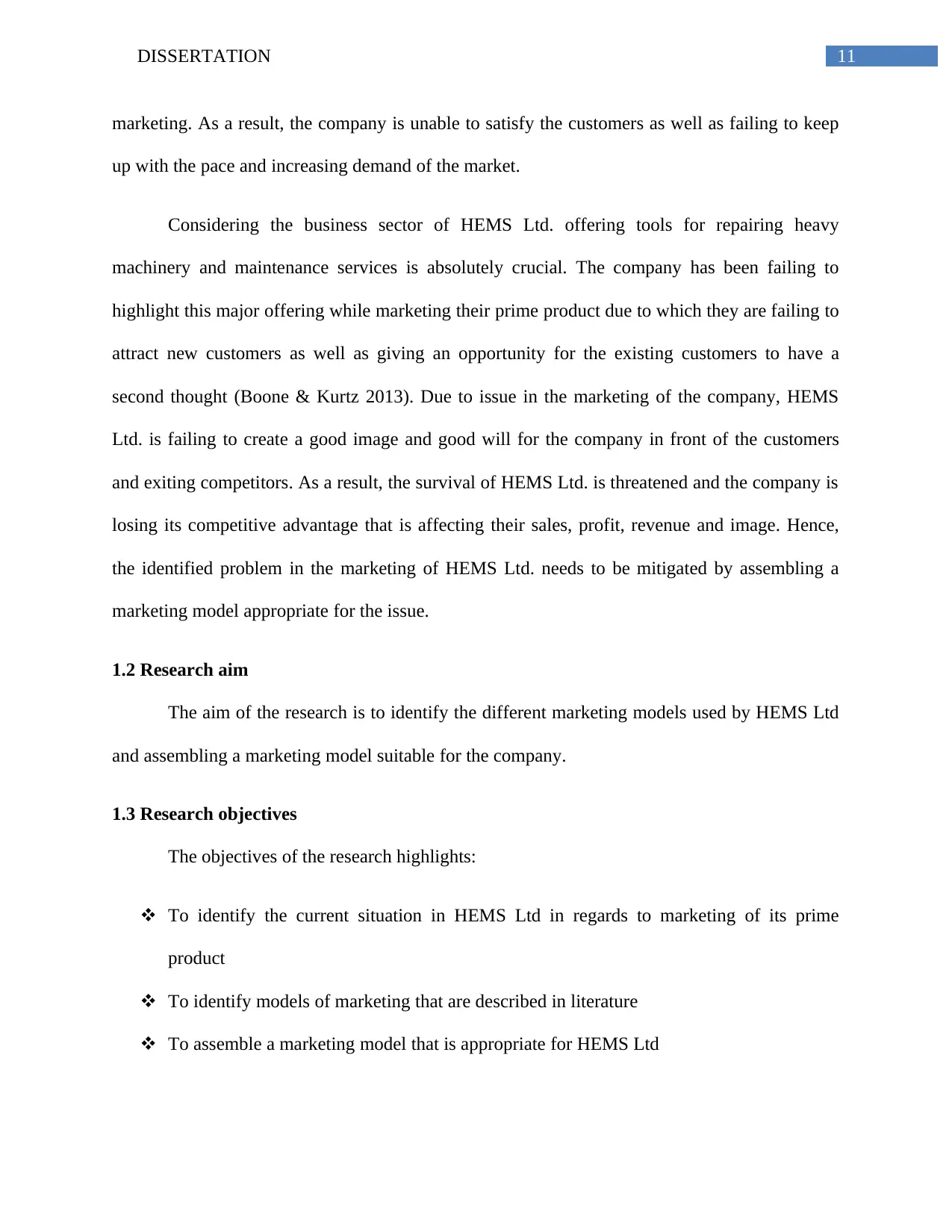
11DISSERTATION
marketing. As a result, the company is unable to satisfy the customers as well as failing to keep
up with the pace and increasing demand of the market.
Considering the business sector of HEMS Ltd. offering tools for repairing heavy
machinery and maintenance services is absolutely crucial. The company has been failing to
highlight this major offering while marketing their prime product due to which they are failing to
attract new customers as well as giving an opportunity for the existing customers to have a
second thought (Boone & Kurtz 2013). Due to issue in the marketing of the company, HEMS
Ltd. is failing to create a good image and good will for the company in front of the customers
and exiting competitors. As a result, the survival of HEMS Ltd. is threatened and the company is
losing its competitive advantage that is affecting their sales, profit, revenue and image. Hence,
the identified problem in the marketing of HEMS Ltd. needs to be mitigated by assembling a
marketing model appropriate for the issue.
1.2 Research aim
The aim of the research is to identify the different marketing models used by HEMS Ltd
and assembling a marketing model suitable for the company.
1.3 Research objectives
The objectives of the research highlights:
To identify the current situation in HEMS Ltd in regards to marketing of its prime
product
To identify models of marketing that are described in literature
To assemble a marketing model that is appropriate for HEMS Ltd
marketing. As a result, the company is unable to satisfy the customers as well as failing to keep
up with the pace and increasing demand of the market.
Considering the business sector of HEMS Ltd. offering tools for repairing heavy
machinery and maintenance services is absolutely crucial. The company has been failing to
highlight this major offering while marketing their prime product due to which they are failing to
attract new customers as well as giving an opportunity for the existing customers to have a
second thought (Boone & Kurtz 2013). Due to issue in the marketing of the company, HEMS
Ltd. is failing to create a good image and good will for the company in front of the customers
and exiting competitors. As a result, the survival of HEMS Ltd. is threatened and the company is
losing its competitive advantage that is affecting their sales, profit, revenue and image. Hence,
the identified problem in the marketing of HEMS Ltd. needs to be mitigated by assembling a
marketing model appropriate for the issue.
1.2 Research aim
The aim of the research is to identify the different marketing models used by HEMS Ltd
and assembling a marketing model suitable for the company.
1.3 Research objectives
The objectives of the research highlights:
To identify the current situation in HEMS Ltd in regards to marketing of its prime
product
To identify models of marketing that are described in literature
To assemble a marketing model that is appropriate for HEMS Ltd
⊘ This is a preview!⊘
Do you want full access?
Subscribe today to unlock all pages.

Trusted by 1+ million students worldwide
1 out of 105
Related Documents
Your All-in-One AI-Powered Toolkit for Academic Success.
+13062052269
info@desklib.com
Available 24*7 on WhatsApp / Email
![[object Object]](/_next/static/media/star-bottom.7253800d.svg)
Unlock your academic potential
Copyright © 2020–2025 A2Z Services. All Rights Reserved. Developed and managed by ZUCOL.





